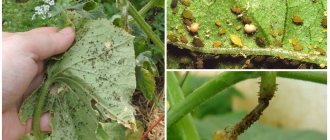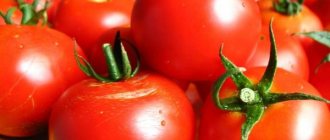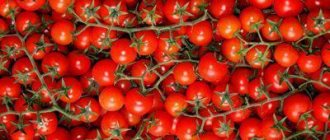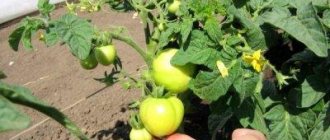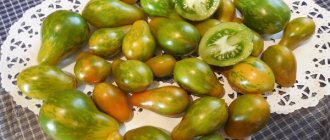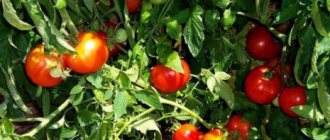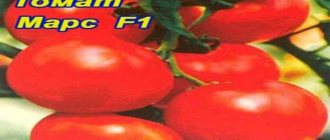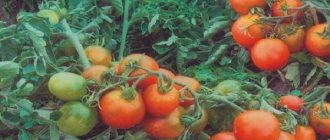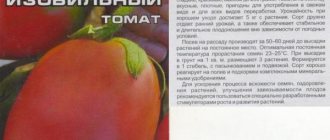Tomatoes "Palenka": description of the variety
| Variety name | Palenque |
| general description | Mid-season indeterminate hybrid |
| Originator | Holland |
| Ripening period | 105-112 days |
| Form | Plum-shaped |
| Color | Red |
| Average weight of tomatoes | 110-135 grams |
| Application | For canning |
| Productivity of the variety | 18.3-21.4 kg per bush |
| Features of cultivation | Standard agricultural technology |
| Disease resistance | Late blight prevention is needed |
Hybrid of indeterminate type, medium-early ripening. From the germination of seedlings to the harvesting of the first ripened tomatoes, it takes from 105 to 112 days. The stem is powerful, formed by one stem on a trellis; tying the bush is required. The height of the bush is from 160 to 185 centimeters .
The first brush is placed above the ninth sheet. From 4 to 7 tomatoes are placed in the brush. The leaves are green, oval, medium in size. Good, early fruit set. The hybrid is included in the State Register of Russia for breeding in film shelters and greenhouses on private plots and small farms.
Advantages of a hybrid:
- Powerful barrel.
- Uniformity of fruits in size and weight.
- Good yield.
- Disease resistance.
The yield of Palenka tomato is from 18.3 to 21.4 kilograms per square meter.
You can compare the yield of this variety with others in the table below:
| Variety name | Productivity |
| Solerosso f1 | 8 kg per square meter |
| Soyuz 8 | 15-19 kg per square meter |
| Aurora f1 | 13-16 kg per square meter |
| Red Dome | 17 kg per square meter |
| Aphrodite f1 | 5-6 kg per bush |
| King of the Early | 12-15 kg per square meter |
| Severenok f1 | 3.5-4 kg per bush |
| Ob domes | 4-6 kg per bush |
| Katyusha | 17-20 kg per square meter |
| Pink fleshy | 5-6 kg per square meter |
Flaws:
- The need to grow in a greenhouse.
- Requirement for bush tying.
Dutch selection tomatoes: the best varieties
Tomatoes brought to Europe by the discoverers of America; at first, tomatoes were grown as ornamental plants.
This was especially true for European countries with temperate climates. Due to lack of heat and sun, the tomatoes simply did not have time to ripen. After tomatoes began to be grown through seedlings, and their green fruits learned to ripen, they became one of the most favorite vegetables on the table of the inhabitants of the Eurasian continent. Holland is one of the world leaders in the selection of tomatoes and the production of their seeds. Let's try to find out which Dutch varieties of tomatoes can be grown in a personal plot.
Seeds of early varieties of tomatoes attract all gardeners because thanks to them, they can produce a harvest in an average of 100 days from the moment of friendly shoots appearing. Early varieties selected by Dutch scientists include:
- Bobcat F1
- Tarpan F1
- President II F1
- Crystal F1
- Big Beef F1
Variety Big Beef F1
This variety belongs to the very large-fruited, so-called beef tomatoes or beefsteak varieties of tomatoes.
Like all varieties of this group, the fruits are large, weighing at least 200 grams; tomatoes weighing 350 grams are not uncommon. The shape is round, the color of a ripe tomato is red, very bright.
Tomatoes have excellent taste and salad purpose. Ripening begins already on the hundredth day after mass germination of seeds.
Important! In order for the fruits to show their varietal characteristics, this variety must be grown in one stem and constantly be planted. The Big Beef F1 variety is grown in open ground on a trellis. The variety is also suitable for greenhouses. The advantage of this variety is its good tolerance to diseases:
- tobacco mosaic
- stem cancer
- fusarium wilt
- nematode
- gray spot
Also, the advantage of the fruit is the increased content of dry matter and the predominance of pulp over the volume of seed nests. If on one square. Do not place more than 2-3 plants per meter, then from one bush you can collect about 5 kg of tomatoes. The disadvantages include the need to install high trellises, more than 2 m.
If the shoots are not fastened to the trellis in time, they may break under the weight of the fruit. Despite the fact that many gardeners strive to grow the earliest varieties, most of the plot area is usually allocated to varieties with an average ripening period.
Medium-ripening tomatoes are most often universal varieties. They are good both fresh and for home canning. Among the medium-ripening tomatoes of the Dutch selection, the following should be noted:
- Organza F1
- Dundee F1
- Picolino F1
- Torbay F1
- Bomax F1
- Yaki F1
Variety Organza F1
These tomatoes are characterized by unlimited shoot growth. The fruits are oval with an obovate shape. During the initial period of ripening, the fruits of the variety are light green in color, and when fully ripe they are bright orange. The weight of the fruit is 45–50 g, the number of seed nests does not exceed three. The taste is excellent; the fruits have a high content of sugar and dry matter.
The purpose is universal. Very suitable for preservation in its entirety. The advantage of the variety is its productivity; from one square meter you can harvest 21 kg of Organza F1 tomatoes. The variety is tolerant to unfavorable weather and most tomato diseases.
Variety Torbay F1
The tomato has pink fruits and excellent taste. It is not inferior in taste to the proven variety Bull's Heart. A variety for open ground and temporary film shelters. The fruits are large, average weight 200.0 g. There is no green spot on the peduncle. The shape is round, with pronounced ribbing, slightly flattened.
When broken, the pulp is sugary. The dense structure of the pulp makes it possible to transport the fruits of this variety over considerable distances without loss of quality and presentation.
It is resistant to fruit cracking. Despite the limited growth, the bushes are no higher than 0.8-0.9 m; when grown, the variety requires tying and shaping. The best way to grow is in two stems. Productivity is good. When placing up to three bushes per square meter. meter bushes are simply sprinkled with pink fruits.
Variety Bomax F1
Tall variety of unlimited growth. The fruits are large, weighing 210 - 220 grams, the color of unripe fruits is green, ripe ones are red. The skin is shiny, glossy. It is grown in open ground with the obligatory formation of bushes and fruit clusters. It is most convenient to grow into one or two shoots, and form the brush into four ovaries.
It withstands transportation very well and is stored fresh without loss of quality for up to 4-5 weeks. Despite the fact that many medium-sized varieties can produce a medium-late harvest, up to 5-10% of the area allocated for tomatoes can be planted with late varieties.
One of the well-known varieties with extended late fruiting is the Dutch variety Super Roma VF. These tomatoes begin to ripen four months after the bulk of the shoots appear. When ripe, the fruits have green stripes; when fully ripe, they become a uniform red color.
The shape is elongated plums, sometimes with a small spout. Average weight - up to 90.0 g. Bushes of limited growth up to 0.6 m in height. The variety has extended fruiting, is very productive, yields up to 15 kg per square meter. m. You can pick them in an unripe state, the tomatoes are well stored and ripen.
The variety is resistant to major tomato diseases. Despite the fact that most Dutch varieties are of hybrid origin, this does not detract from their merits. In the process of working on new hybrids, breeders conduct targeted pollination of one tomato variety with another. The result of such pollination is first-generation hybrids, which are superior in quality to the parent forms.
The work of Dutch breeders is aimed at creating tomato hybrids that are maximally adapted to the climatic and agrotechnical characteristics of regions around the globe. Dutch holdings develop tomato varieties for year-round cultivation and undergo strict certification and pre-sale training.
Features include disease resistance, adaptability to growing conditions - bush height, self-pollination, harvest amount.
This article contains hybrids that are grown in Russia and are suitable for greenhouse conditions and open ground.
Features of seeds
Seeds of Dutch selection are distinguished by three characteristics:
- Relatively low costs for caring for tomatoes. Because These varieties are very unpretentious, but very prolific.
- Increased resistance to diseases and pests. Hybrids are able to ignore most plant diseases.
- High yield per square meter. Specialists are able to get 2 times more fruits than from traditional types of tomatoes.
Varieties are distinguished according to several characteristics. There are species for growing in open ground and for closed soil (under film or in greenhouses).
An early hybrid of Dutch tomato with high yielding ability. It has a very short ripening period and a long fruiting period. The time from the moment of planting seedlings to obtaining the first ripened tomatoes usually takes 88-92 days.
The variety can be grown both in open ground and under film. The color of the unripe fruit is light green, the mature one is red. The weight of one fruit varies from 180 to 220 g. The maximum yield can be 9.1 kg per sq.m.
This variety does not respond to verticillium and fusarium wilt.
Read about Adam cucumber seeds here.
Sowing seeds for seedlings should be done 60 days before planting in the ground. Usually the seeds are treated with thiram and do not require soaking.
Sultan
The most productive tomato variety that can withstand the harsh natural conditions of a continental climate. Mid-early appearance (95-110 days between planting seedlings and ripening).
The variety is powerful, low-growing, the stems are well developed and do not require garter. The fruits are large and fleshy, weighing about 150-200 g in a rich red hue. They have good taste.
Productivity can increase up to 15 kg per 1 sq.m. with proper care.
Tarpan
The variety is mid-early (98-105 days), heat-resistant and large-fruited. Can be grown in open ground and under film cover. The bush is medium sized and compact.
The fruits are dense and juicy, and have the special taste qualities characteristic of pink tomatoes. The weight of an average tomato in open ground reaches 130-160 g, in greenhouse conditions 160-180 g. Ripe fruits have a beautiful pink color (with mother-of-pearl).
The variety is not prone to cracking. The harvest brings up to 6 kg per sq.m.
This species can be grown when thickened - up to 5 seedlings per 1 sq.m. Fertility increases by 90%, and the size of the tomatoes remains virtually unchanged.
Mid-early type of tomatoes (107-110 days), used for open ground and greenhouses. The bush is powerful, compact and heat-resistant. Does not require additional shaping, which greatly facilitates its care.
The fruits are dense, red in color and high in sugar. The variety is light and not prone to cracking. Resistant to diseases such as stem canker, gray leaf spot, and verticillium wilt.
Productivity allows you to collect up to 3 kg from 1 sq.m. with proper care.
Super Red
Early ripening high-yielding variety (65-70 days). The bush is powerful, but compact, requires garter and shaping. The average weight of the fruit is 160-200 g with a uniform bright red color.
Excellent for growing in hot conditions. Resistant to Fusarium and Verticillium wilt, tomato mosaic viruses and yellow leaf curl of tomato.
Has high yield potential.
Polfast
Early type of tomato (86-91 days). Low growing and high yielding. The fruits are fleshy, bright red, weighing up to 150 g. They do not crack during storage and have a good taste. The yield can reach 6.2 kg per sq.m. The variety is not susceptible to fusarium and verticillium. Due to early ripening, it is not affected by late blight.
It has good knotting properties at low temperatures. As a result, it is suitable for growing in open soil in the middle climate zone.
Crystal F1
Crystal F1
Crystal F1
- View the full image
Characteristics
- The shape of the fruit resembles a plum.
- Ripe tomatoes of rich red color.
- The fruits are even in size, weighing 110 - 135 grams.
- Excellent presentation, good safety during transportation.
- It is used in various types of pickles and marinades. In salads they give a slight sourness.
| Variety name | Fruit weight |
| Palenque | 110-135 grams |
| Rio Grande | 100-115 grams |
| Honey | 350-500 grams |
| Orange Russian 117 | 280 grams |
| Tamara | 300-600 grams |
| Wild Rose | 300-350 grams |
| Honey King | 300-450 grams |
| Apple Spas | 130-150 grams |
| Thick cheeks | 160-210 grams |
| Honey Drop | 10-30 grams |
Description of the hybrid
Palenca is a hybrid, not a tomato variety. Its characteristics and description indicate high productivity even in unfavorable conditions. The plant is indeterminate, with unlimited growth of the main stem.
The height reaches 2 m and therefore requires gartering and pinching of plants. The foliage is medium, the leaves are rich green, the branches are spreading. The first flower cluster is placed above the 9th leaf, subsequent ones every 2-3 leaves. Each brush produces 5–7 ovaries in all weather conditions.
Mid-early species: harvesting begins 105–115 days after emergence. Tomato is immune to a number of dangerous diseases, such as:
- tobacco mosaic virus;
- fusarium and verticillium leaf wilt;
- cladosporiosis (brown spot);
- root rot.
These diseases have different etiologies: viral and fungal. Both are equally dangerous for plants. During an outbreak of infections, most of the plantings die. When damaged by fungi, seedlings can be cured by identifying the disease at an early stage. However, a viral infection is practically untreatable. Therefore, a big plus for any culture is its immunity.
In addition, neighboring plants can also become infected, as happens with brown spot, tobacco mosaic, fusarium and verticillium. With these diseases, the appearance of the leaves and their color are modified. Subsequently they wither and the plant dies. Root rot causes rotting of the roots and death of stem tissue.
Despite Palenca's strong immunity against many dangerous diseases, it is practically not protected from late blight. Therefore, you should take care of the necessary preventive measures in advance.
Yield indicators
The culture is recommended for cultivation under film cover and in greenhouse conditions. Nevertheless, in the southern regions, tomatoes are successfully grown in open beds, although under such conditions high fruiting rates cannot be achieved.
Reference . The creator of the hybrid claims high productivity only in closed ground.
When planted in a greenhouse, 6-7 kg of excellent fruits are collected from 1 seedling, provided that no more than 3 plants are planted per 1 m2.
Description of fruits
The photo shows Palenque tomatoes.
The average weight of ripe tomatoes is 100–130 g, oval in shape, slightly elongated, similar to cream. The color is deep red, the taste is excellent, sweet, with a pronounced sourness characteristic of tomatoes.
The pulp is juicy and dense. The peel is thin, but strong enough for long-distance transportation. During long-term storage, vegetables retain their presentation. For these reasons, the variety is a success among entrepreneurial farmers who grow it on an industrial scale. Ripe tomatoes are in great demand in markets.
The purpose of the fruits is universal: they are suitable for preparing various fresh dishes, winter preparations and processing into tomato products.
Disease resistance
The tomato hybrid “Palenka F1” shows average resistance to the following diseases:
- Fusarium wilt.
- Tomato mosaic virus.
- Verticillium wilt.
- Fusarium root rot.
- Cladosporiosis.
We bring to your attention useful information on the topic: How to grow a lot of tasty tomatoes in open ground? How to get excellent harvests in greenhouses all year round? What subtleties of agricultural technology of early varieties should everyone know?
Features of cultivation
To obtain strong and healthy seedlings, it is important to adhere to certain rules: the timing of sowing seeds and planting seedlings in the ground.
Sowing seeds and first shoots
Experienced gardeners know that seeds of hybrid crops will have to be purchased for each planting. Of course, you can collect the material yourself, but this does not make any sense, since hybrids do not retain their parental properties in the next generation.
Purchased seeds do not need to be treated with a growth stimulant or disinfected: the manufacturer takes care of this himself.
Reference . You can buy Palenque tomato seeds at any specialty store. Distribution is handled by Agro or Semco Junior.
The soil is prepared from peat, turf soil and humus in equal quantities. A little potassium fertilizer and superphosphate are added to the resulting mixture for greater nutritional value. Then pour over a hot solution of potassium permanganate to destroy pathogenic spores.
For sowing, a common wooden box is used, followed by transplanting the seedlings into individual containers. The box is treated with a dark solution of potassium permanganate and filled with soil.
Seeds are planted in furrows 1.5 cm deep and at a distance of 2–2.5 cm from each other. Moisten with a spray bottle with warm, settled water and cover with film. Planting containers are left in a warm room at a temperature of 23–25°C.
Reference . To obtain healthy seedlings, it is important to maintain the correct temperature conditions.
After the shoots emerge, the film is removed and the containers are placed on the windowsill. The temperature remains at the same level for 2 weeks.
Seedling care
Water the seedlings moderately, as the top layer of soil dries out, with warm, settled water using a shallow watering can. There is no need to flood the soil; this risks the development of fungal diseases.
Afterwards, the soil is loosened superficially, improving the air permeability of the soil.
As the seedlings take root, the temperature is reduced to 20°C. At lower values, the first flower cluster will form too low, which will negatively affect the further development of seedlings.
Recommendations for cultivation
For seedlings, experienced gardeners advise planting seeds in the second ten days of March. Before planting, it is recommended to treat the seeds with a solution of potassium permanganate.
Picking is best done when the third true leaf appears. It is advisable to combine it with fertilizing with mineral fertilizer containing copper. Before planting seedlings, it is recommended to add a handful of crushed egg shells into the hole. After planting, water abundantly with water at room temperature.
Read useful articles about fertilizers for tomatoes:
- Organic, mineral, phosphorus, complex and ready-made fertilizers for seedlings and the TOP best.
- Yeast, iodine, ammonia, hydrogen peroxide, ash, boric acid.
- What is foliar feeding and when picking, how to carry it out.
Rules for planting and care
In order to consistently harvest a good harvest of Palenque tomatoes, you need to adhere to the most basic rules, which will be discussed. There is nothing complicated or new in this; all the features of planting and care have been known for a long time.
The description states that sowing Palenque tomatoes should begin 2-3 months before transplanting into the greenhouse. As a rule, this is the beginning of March. It is better to sow in a common container and then dive into separate cups.
Important! Dutch seeds are sold already prepared for planting, so there is no need to additionally soak them in growth stimulants.
But you need to pay special attention to the soil. For planting, use a loose, nutritious substrate. It must contain peat, turf humus, potash fertilizers and superphosphate. Prepare the soil yourself or use store-bought soil, which is preferable, since all components are in the required proportions.
To grow strong Palenca tomato seedlings, you need to maintain the correct room temperature:
- before emergence and the first 14 days – 23-25°C;
- when the seedlings get stronger – 20°C;
- before planting – no higher than 18-19°C.
If the temperature is too low, the first flower cluster will set too low, which is bad for the plant as a whole.
Caring for Palenca seedlings is simple. Seedlings need regular watering, fertilizing, fresh air and picking. It is better to water with settled warm water, but so as not to flood the soil. The soil must dry out between waterings, otherwise blackleg cannot be avoided.
You need to feed the seedlings 2 times. To do this, add a solution of mineral complexes 14 days after picking and 2 weeks before planting in the ground. The concentration of working solutions is reduced so as not to harm the seedlings.
You need to ventilate the greenhouse where the cassettes with seedlings are located several times a day, gradually accustoming the plants to the environment.
As for the packaging for picking, you need to take care of it in advance. Palenque tomatoes should not be kept in cramped conditions, otherwise this will negatively affect the yield. Each plant requires a container of at least 500 ml. They don’t dive into such containers right away; first they use smaller cups.
Picking of Palenque seedlings begins after the appearance of the 3rd true leaf. Work carefully so as not to damage the root system of the seedlings. If necessary, plants are buried 1.5 cm into the soil.
Transplanting seedlings
The plants are transferred to the greenhouse as soon as the soil warms up enough. You should not do this too early, otherwise the bushes will take a long time to take root and become sick. The soil temperature should be within 18°C. If the difference between day and night temperatures is significant, then you should wait, otherwise the Palenca tomato will shed its ovaries.
The soil in the greenhouse is prepared in the fall, when the main crops are harvested. The bed for Palenka tomatoes is dug up, humus, superphosphate and ash are added. Plants are planted according to the standard scheme, where per 1 sq. m – no more than 3 plants. 7-10 days after planting, the shoots are tied to supports. As they grow, they are directed onto a trellis and the stem is twisted around.
Tomato care
From photos of Palenque tomatoes, of which there are many on the Internet, one can judge the high yield of the variety. From the reviews of summer residents it follows that such success can only be achieved by proper care of the bushes.
First of all, there is no need to allow high air humidity in the greenhouse. If this cannot be adjusted, then after each watering, ventilate the room and loosen the soil. This rule should not be neglected, otherwise fungal diseases will not keep you waiting.
In addition, good lighting and ventilation of the bushes will benefit them. For better air aeration, the lower leaves on Palenque tomatoes are removed. This is done carefully so as not to injure the central shoot. This procedure also promotes better lighting for plants.
Warning! The bushes are formed into one stem, all excess shoots and leaves are removed as the plant grows.
Throughout the entire growing period, the variety needs fertilizing, which is done every 2-3 weeks. Organics and mineral complexes are used. You can alternate them with each other.
Water the Palenque tomato bushes regularly, otherwise the fruits will become smaller, crack, and the ovary will stop forming.
Basic recommendations for further care of the Palenka hybrid:
- Seven days later, after the seedlings have taken root, the stems are tied to a vertical trellis using twine. Subsequently, every 3-4 days the main stem is braided around the twine. This will prevent the bush from sliding down under the weight of its own fruits;
- In a greenhouse structure, a certain temperature regime must be maintained. Sudden temperature changes lead to the shedding of ovaries. In order to avoid this during the fruiting period, the soil must be heated to 18 ºС, and the air to 25 ºС during the daytime and up to 18 ºС at night;
- Seedlings should also be provided with good lighting;
REFERENCE: Proper formation of the stem will prevent the plantings from becoming crowded.
- An equally important factor is the level of humidity in the greenhouse structure. High humidity in a greenhouse provokes the occurrence of fungal diseases. To prevent this, it is recommended to water no more than twice a week, after which the soil is loosened and the greenhouse is ventilated;
- Removing the lower and older leaves up to the first cluster helps improve the ventilation of the bushes. Leaves are torn off only to the side, since torn off in a downward direction leads to injury to the stem;
- It is necessary to carry out regular feeding, alternating every 2-3 weeks. The first time is fed two weeks after planting in a greenhouse structure. All fertilizing is carried out using complex mineral fertilizers. The working solution will be required at the rate of 0.5 liters per 10 m2.
- Indeterminate types of tomatoes require pinching and bush formation, otherwise an impenetrable tomato jungle will very quickly form in your greenhouse. As soon as the seedlings are planted in greenhouse soil, do not take your eyes off them and plant the plant in time.
- Install trellises or other structures in advance to support tall tomato stems. This is done before planting the seedlings in the ground.
- Many hybrids require pollination. Always take this into account and open the greenhouse so that bees, bumblebees or wasps can easily enter the room. If this is not possible, pollinate yourself using a brush and a fan. To do this, shake the flowers with a brush while the fan is on - pollination will occur automatically. You can shake flowers with your hands, the main thing is not to overdo it and not tear off the flower. Do everything carefully.
- For good development of tomatoes, harvest on time. Please note that the fruits of Dutch hybrids are very large and must be removed from the bush in a timely manner. As soon as the plant bears fruit, change the soil mixture to new soil. If this is not possible, plant green manure, such as mustard. Also treat the soil with a solution made from water and wood ash. The earth will rest and gain nutrients. Dutch hybrids can be grown year-round in a heated greenhouse.
By growing hybrids of Dutch selection, gardeners manage to collect huge harvests and successfully sell them without losses. The fruits are perfectly stored, do not deteriorate during transportation and have excellent taste.
Diseases and pests
One of the most common diseases of tomatoes is late blight. The disease begins with the leaves, they turn yellow. They become covered with brown spots, then the disease spreads to tomato fruits. The disease spreads very quickly. One bush can cause all the bushes in the greenhouse to get sick and die within two days.
Treating the soil with Mikosan can prevent late blight. Experienced gardeners recommend treating diseased plants with preparations such as Antrakol or Acrobat.
The tomato hybrid “Palenka F1” may be of interest not only to private owners. It will be of interest to farmers due to the even weight and size of the fruits, which have excellent transportability and good presentation.
Medium ripening
Breeders have bred and continue to create tomatoes whose fruits will not ripen at the same time. The first tomatoes are harvested 2 months after the sprouts appear, the last ones in the fall.
Early ripening
Summer residents usually allocate at least a little space to plant hybrids that will quickly ripen. Early tomatoes are not entirely suitable for canning and pickling and are consumed immediately.
Vegetables that are harvested by the beginning of autumn are better suited for storage and canning. They accumulate sugar and acquire sweetness.
Organza F1
Summer residents are happy to buy raceme tomato seeds produced by a Dutch company. The tall hybrid pleases with its productivity, from 1 sq. meters, up to 20 kg of fruits are collected, which have:
- bright orange color;
- interesting oval shape;
- high dry matter content.
Tomatoes weigh about 50 grams and are placed whole in jars. The variety tolerates unfavorable conditions and rarely suffers from diseases.
Torbay F1
The hybrid grows only up to 80 cm in height, but the bush is tied to a trellis and 2 stems are left when forming. During ripening, the plants are literally strewn with large tomatoes of a very beautiful pink color. The weight of the ribbed fruits approaches 200 g. The pulp contains a lot of juice.
Bomax F1
The hybrid is characterized by unlimited growth and bears fruit well in a field or garden bed, provided that the clusters are formed correctly. Tomatoes ripen in the middle period, the green tint changes to a classic rich color. Tomatoes weigh about 200 g, do not crack during transportation, and can be stored for up to one and a half months.
Video
We invite you to watch a video about productive tomato varieties, including Palenca tomatoes:
| Mid-early | Super early | Mid-season |
| Ivanovich | Moscow stars | Pink Elephant |
| Timofey | Debut | Raspberry Onslaught |
| Black truffle | Leopold | Orange |
| Rosaliza | President 2 | Bull forehead |
| Sugar giant | Pickling miracle | Strawberry dessert |
| Orange giant | Pink Impression | Snow fairy tale |
| One hundred pounds | Alpha | Yellow ball |
If you find an error, please select a piece of text and press Ctrl+Enter.
Advantages and disadvantages
- Among the advantages of this type of tomatoes are the following:
- ease of care;
- the ability to grow the product in different climatic zones;
- long shelf life;
- resistance to some tomato diseases;
- suitability for long-term transportation;
- a large amount of harvest.
- In contrast to the positive qualities, there are several disadvantages of Palenki:
- mandatory tying and removal of stepsons;
- cultivation only in closed soil conditions;
- lack of resistance to a number of diseases.
